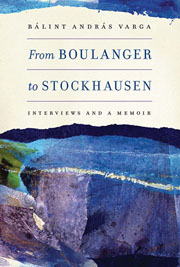Book contents
- Frontmatter
- Dedication
- Contents
- Foreword
- Acknowledgments
- Part One Interviews
- Preface to the Interviews
- Composers
- Conductors
- Instrumentalists
- Singers and a Record Producer
- A Teacher
- Music Administrators
- Snippets
- Claudio Abbado
- Sir Neville Cardus
- Aaron Copland
- Antal Doráti
- Géza Frid
- Sylvia Goldstein
- Ralph Kirkpatrick
- Witold Lutosławski
- Vlado Perlemuter
- Arthur Rubinstein
- György Sándor
- Walter Susskind
- Joseph Szigeti
- Part Two A Memoir
- Notes in Retrospect
- Index
- Miscellaneous Endmatter
Claudio Abbado
from Snippets
Published online by Cambridge University Press: 05 January 2014
- Frontmatter
- Dedication
- Contents
- Foreword
- Acknowledgments
- Part One Interviews
- Preface to the Interviews
- Composers
- Conductors
- Instrumentalists
- Singers and a Record Producer
- A Teacher
- Music Administrators
- Snippets
- Claudio Abbado
- Sir Neville Cardus
- Aaron Copland
- Antal Doráti
- Géza Frid
- Sylvia Goldstein
- Ralph Kirkpatrick
- Witold Lutosławski
- Vlado Perlemuter
- Arthur Rubinstein
- György Sándor
- Walter Susskind
- Joseph Szigeti
- Part Two A Memoir
- Notes in Retrospect
- Index
- Miscellaneous Endmatter
Summary
I interviewed the conductor in Budapest in 1968. He was thirty-five, I was twenty-seven. We were both happy-go-lucky young men and chatted rather than did a serious interview. I mean it was certainly serious in its intent but the way Abbado talked to me, munching on an apple and speaking with his mouth full, was totally relaxed. We were to meet many more times over the years and I became his “official” interviewer: whenever he appeared in Budapest, I would turn up in his hotel room with my microphone.
The subject of his nearsightedness—which he shared with Arturo Toscanini—also came up.
O
Claudio Abbado (CA): I played and conducted a Bach piano concerto in Milan with Toscanini in the audience. After the concert, we talked for a long time. I am, as you know, nearsighted and he explained that it was more important for the orchestra to see the conductor's eyes, than for the conductor to see the orchestra. And if you conduct by heart, it is better anyway not to wear glasses.
Bálint András Varga (BAV): Do you always conduct without a score?
CA: Always. If I were to use a score, it would mean that I have not learned the piece properly. I want to know compositions thoroughly, in all their details. Often, I study a work for several years, such as Wozzeck or Tristan.
But to get back to my memories of great masters: Toscanini once expressed the view that Furtwängler's tempi in Beethoven's Ninth Symphony were too slow.
- Type
- Chapter
- Information
- From Boulanger to StockhausenInterviews and a Memoir, pp. 231 - 232Publisher: Boydell & BrewerPrint publication year: 2013



